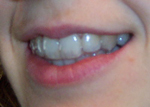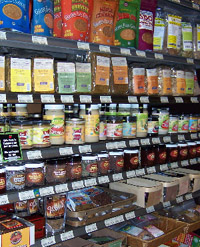Most vegans shouldn’t lecture about health
Tuesday, October 30th, 2007Animal activists, when promoting the vegan diet, often focus on the health benefits because they believe that people will care more about their own health than about animal suffering. We need to rethink this strategy. A vegan who is out of shape, has bad skin, or is sucking down potato chips, has no business telling anyone how to be healthy, and has little chance of convincing a meat-eater to go vegan on health grounds.
In this age of limitless vegan junk food options, the vegan diet is no longer a free ticket to better health. Most vegans, just like the rest of the Western world, are not healthy. The only difference is that many of the unhealthy vegans believe they are healthy by mere virtue of the fact that they are strict vegans, regardless of how many vegan donuts and corn dogs they consume. If you are still telling people that veganism will save them from diabetes and cancer, you are spreading misinformation. Because of the wide array of acidifying, sugary, processed vegan foods, it is quite possible to develop these life-threatening conditions while maintaining a vegan diet. There is nothing wrong with discussing health issues with the public, especially when combating the misconception that one cannot be healthy on a vegan diet. Eliminating meat and dairy is certainly an important aspect of optimal health, but so is eliminating many other ingredients that may still be vegan.
If you are vegan for health reasons, then by all means, promote the vegan diet on those grounds. Health-seekers will find your enthusiasm and experience inspiring. If you don’t actually know much about what constitutes a healthy diet, telling omnivores that they need to be vegan to be healthy will not be effective. Even if your statements about health are true, the fact that they come from a disingenuous place will show through. On the other hand, if you speak from a genuine passion for ending animal suffering, thoughtful, intelligent people will appreciate your honesty and integrity and will be more open to your message, even if they don’t agree with you.
Veganism is an ethical movement. It is not a health movement. Those who eliminate animal products from their diets purely for health reasons don’t tend to identify with the label “vegan.” Why would someone who is only interested in improving his health take advice from a vegan animal rights activist? People are more confused than ever about health issues these days, and are wary of those who push their health solutions for ulterior motives – whether those motives are financial or political. This confusion also causes dieters to shift their opinions every time a new study comes out. If you convince people to switch to a vegan diet for health reasons, all it will take to lose them is a new Atkins-like diet fad, extolling the virtues of a meat-based diet.
Even if a person doesn’t support the idea that an animal deserves its life, they can still look at the horrific conditions and abuses of factory farming and make a compassionate decision to eliminate or reduce the animal products in their diet. Public opinion is shifting in favor of animal welfare, so don’t perpetuate the perception that people don’t care about animals. But if you still want to show meat-eaters that veganism is a path to good health, then set a good example and actually be a healthy vegan.
![[del.icio.us]](https://www.vegangirl.com/wp-content/plugins/bookmarkify/delicious.png)
![[Digg]](https://www.vegangirl.com/wp-content/plugins/bookmarkify/digg.png)
![[Facebook]](https://www.vegangirl.com/wp-content/plugins/bookmarkify/facebook.png)
![[Google]](https://www.vegangirl.com/wp-content/plugins/bookmarkify/google.png)
![[Ma.gnolia]](https://www.vegangirl.com/wp-content/plugins/bookmarkify/magnolia.png)
![[MySpace]](https://www.vegangirl.com/wp-content/plugins/bookmarkify/myspace.png)
![[Reddit]](https://www.vegangirl.com/wp-content/plugins/bookmarkify/reddit.png)
![[StumbleUpon]](https://www.vegangirl.com/wp-content/plugins/bookmarkify/stumbleupon.png)
![[Technorati]](https://www.vegangirl.com/wp-content/plugins/bookmarkify/technorati.png)
![[Twitter]](https://www.vegangirl.com/wp-content/plugins/bookmarkify/twitter.png)
![[Yahoo!]](https://www.vegangirl.com/wp-content/plugins/bookmarkify/yahoo.png)
![[Email]](https://www.vegangirl.com/wp-content/plugins/bookmarkify/email.png)
 Invisalign, which offers a series of removable trays to align the teeth, has become a widely popular alternative to traditional braces. Invisalign trays are nearly impossible to detect, making them especially popular among adults who don’t want the adolescent look of braces. Rather than being cemented to your teeth like traditional braces, they can be removed entirely when eating or brushing your teeth, so you no longer have to worry about abstaining from certain foods or not being able to floss properly. While Invisalign offers considerable benefits, there are negatives as well which should be considered. No one told me about these reasons to not get Invisalign. I offer them now so that other people can make more informed decisions:
Invisalign, which offers a series of removable trays to align the teeth, has become a widely popular alternative to traditional braces. Invisalign trays are nearly impossible to detect, making them especially popular among adults who don’t want the adolescent look of braces. Rather than being cemented to your teeth like traditional braces, they can be removed entirely when eating or brushing your teeth, so you no longer have to worry about abstaining from certain foods or not being able to floss properly. While Invisalign offers considerable benefits, there are negatives as well which should be considered. No one told me about these reasons to not get Invisalign. I offer them now so that other people can make more informed decisions: